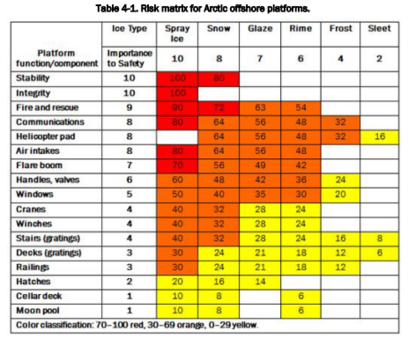Offshore platforms
Jump to navigation
Jump to search

Ryerson (2009) [1] developed a risk matrix for offshore platforms (the figure risk matrix for Arctic offshore platforms.). The matrix identifies spray icing as most serious, and snow as second most serious. Because spray ice and snow can add many tons of ice to an offshore platform owing to its large weather deck area, then stability was the largest safety concern.
The risk matrix attempts to identify the types of ice that are the greatest threat to the vessel and the areas and functions of the vessel most affected by ice. A cross-tabulation then identifies the importance of ice type versus the areas or functions of the vessel most affected by ice.
References
- ↑ Ryerson, C. C. 2009. Assessment of superstructure ice protection as applied to offshore oil operations safety; ice protection technologies, safety enhancements, and development needs. ERDC/CRREL TR-09-4. Hanover, NH: US Army Engineer Research and Development Center.
- ↑ Charles C. Ryerson. April 2013. Icing Management for Coast Guard Assets. Cold Regions Research and Engineering Laboratory. ERDC/ C R R E L TR-13-7.